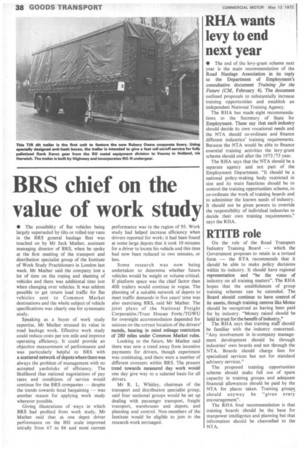BRS chief on the value of work study
Page 40

If you've noticed an error in this article please click here to report it so we can fix it.
• The possibility of fiat vehicles being largely superseded by tilts or rolled-top vans in the BRS general haulage fleet was touched on by Mr Jack Mather, assistant managing director of BRS, when he spoke at the first meeting of the transport and distribution specialist group of the Institute of Work Study Practitioners in London last week. Mr Mather said the company lost a lot of time on the roping and sheeting of vehicles and there was additional time lost when changing over vehicles. It was seldom possible to get return load traffic for flat vehicles sent to Common Market destinations and the whole subject of vehicle specifications was clearly one for systematic study.
Speaking as a buyer of work study expertise, Mr Mather stressed its value in road haulage work. Effective work study could reduce costs per ton mile and improve operating efficiency. It could provide an objective measurement of performance and was particularly helpful to BRS with a scattered network of depots where there was always the problem of management with no accepted yardsticks of efficiency. The likelihood that national negotiations of pay rates and conditions of service would continue for the BRS companies — despite the trends towards local bargaining — was another reason for applying work study wherever possible.
Giving illustrations of ways in which BRS had profited from work study, Mr Mather said that at one depot driver performance on the BSI scale improved initially from 67 to 84 and most current performance was in the region of 95. Work study had helped increase efficiency when drivers reported for work; it had been found at some large depots that it took 10 minutes for a driver to locate his vehicle and this time had now been reduced to two minutes, or less.
Some research was now being undertaken to determine whether future vehicles would be weight or volume critical. If platform space was the chief factor then 40ft trailers would continue in vogue. The planning of a suitable network of depots to meet traffic demands in five years' time was also exercising BRS, said Mr Mather. The joint plans of the National Freight Corporation /Trust Houses Forte /TGWU for overnight accommodation depended for success on the correct location of the drivers' motels, bearing in mind mileage restriction of 280 miles under Common Market rules.
Looking to the future, Mr Mather said there was now a trend away from incentive payments for drivers, though experiment was continuing, and there were a number of different concepts within BRS. The present trend towards measured day work would one day give way to a salaried basis for all drivers.
Mr R. L. Whitley, chairman of the transport and distribution specialist group, said four sectional groups would be set up dealing with passenger transport, freight transport, warehouses and depots, and planning and control. Non-members of the Institute would be eligible to join in the research work envisaged.
















































































































































































































